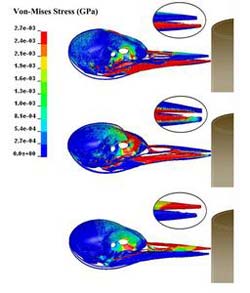Woodpecker research unlocks the key to avoiding head injury

Comuptation models were developed by the researchers to show the stress distributions with different lengths of beaks. Copyright : PolyU<br>
A pioneering study by researchers of The Hong Kong Polytechnic University (PolyU) and the Beihang University in Beijing has unravelled the mystery of why woodpeckers don't hurt themselves in the act of pecking on the trees. This finding is expected to provide fresh insights on the safety design of helmets and other related products.
The research was jointly led by Professor Ming Zhang of PolyU's Department of Health Technology and Informatics and Professor Yubo Fan of Beihang University. A series of experimental studies and computer simulation were conducted. Two synchronous high-speed video systems were used to observe the pecking motion, and a force sensor was used to measure the pecking force. The mechanical properties and macro/micro morphological structure in the woodpecker's head were investigated using a mechanical testing system and micro-CT scanning. Computational models of the woodpecker's head were established to study the dynamic intracranial responses.
Based on the result of this study, the research team has come up with answers on why the repeated daily head-banging motion of woodpeckers does not sustain any brain injury. The experimental data and simulation showed that three factors are at work in sparing the injury.
Firstly, the skulls of woodpeckers are protected by hyoid bone's looping structures which acts as a kind of “safety belt”. Secondly, the upper and lower halves of the birds' beaks are uneven in length – this asymmetry lowers the impact of pecking force transmitted from the tip of the beak onto the brain. Last but not least, the “spongy” bone structure at different points in the skull helps distribute the incoming force, thereby protecting the brain.
The team says it's the combination of these three features that allows woodpeckers to peck without injury. It is anticipated that more quantitative studies will take place before applying the bio-mechanism to human protective device design and probably industry design.
The study was published in the online edition of PloS ONE journal.
Press Contacts
Professor Ming Zhang
Department of Health Technology and Informatics
Tel: (852) 2766 4939
Email: ming.zhang@polyu.edu.hk
Media Contact
All latest news from the category: Life Sciences and Chemistry
Articles and reports from the Life Sciences and chemistry area deal with applied and basic research into modern biology, chemistry and human medicine.
Valuable information can be found on a range of life sciences fields including bacteriology, biochemistry, bionics, bioinformatics, biophysics, biotechnology, genetics, geobotany, human biology, marine biology, microbiology, molecular biology, cellular biology, zoology, bioinorganic chemistry, microchemistry and environmental chemistry.
Newest articles

Bringing bio-inspired robots to life
Nebraska researcher Eric Markvicka gets NSF CAREER Award to pursue manufacture of novel materials for soft robotics and stretchable electronics. Engineers are increasingly eager to develop robots that mimic the…

Bella moths use poison to attract mates
Scientists are closer to finding out how. Pyrrolizidine alkaloids are as bitter and toxic as they are hard to pronounce. They’re produced by several different types of plants and are…

AI tool creates ‘synthetic’ images of cells
…for enhanced microscopy analysis. Observing individual cells through microscopes can reveal a range of important cell biological phenomena that frequently play a role in human diseases, but the process of…





















